Ya sea que usted simplemente esté recién empezando con la tecnología digital o le interese explorar nuevas direcciones para su negocio, es de suma importancia saber elegir tintas. Todo desde la configuración de tintas hasta la composición química de éstas afectará lo que pueda hacer y los resultados obtenidos.
No existe una tinta en particular que pueda lograrlo todo, ni una impresora que pueda usar todos los tipos de tinta; pero si usted sabe qué es lo que necesita hacer, podrá especificar mejor los componentes necesarios para su operación gráfica.
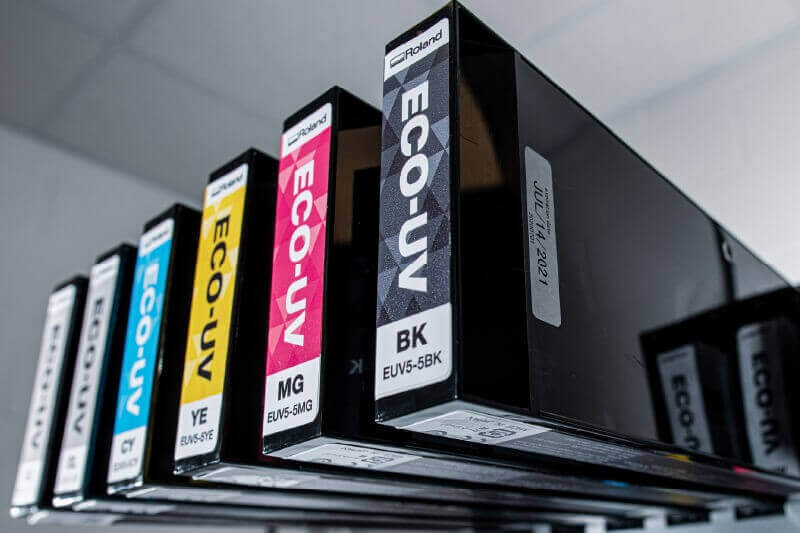
Cada canal de tinta en su impresora puede entregar un tipo o color de tinta.
¿Qué es una Configuración de Tintas?
Cualquier impresora digital que usted compre tendrá un número limitado de canales de tintas, usualmente cuatro u ocho, y cada canal puede entregar un solo color o tipo de tinta. Antes de elegir una impresora digital, usted necesitará decidir qué tintas querrá instalar en cada canal, ya que esto determinará el tipo de trabajos que podrá producir y cuán rápido los hará.
Colores y Tipos de Tintas
Antes de prestar atención a las diferentes tecnologías de tintas, aquí tenemos algunas categorías comunes a casi toda tecnología:
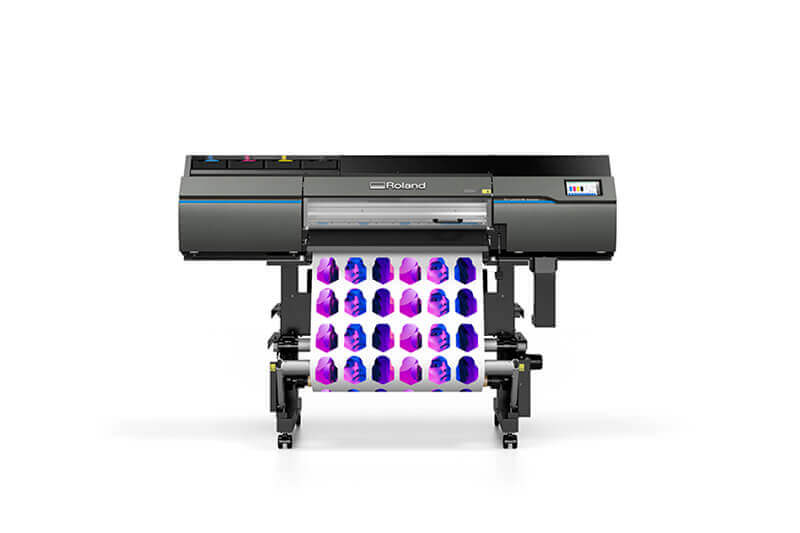
Los vibrantes colores y las gradaciones suaves permiten que sus gráficos se destaquen.
CMYK
CMYK es la configuración fundamental de cuatro colores que usted encontrará en prácticamente toda solución de impresión a colores. Las siglas representan los colores Cyan (C), Magenta (M), Amarillo (Y) y Negro (K*), y con estos cuatro colores usted puede producir de forma adecuada la mayoría de aplicaciones cromáticas.
*¿Por qué la K en CMYK significa “negro”?
K es “Key” (“clave”) o “Key Plate” (“placa clave”), un término proveniente de los procesos de impresiones manuales que se refiere a la placa de registro con la cual las demás placas (C, M e Y) están alineadas.
COLORES LIGEROS
Usted puede encontrar sombras más claras de tinta para cyan, magenta y negro; a menudo abreviadas como Lc, Lm y Lk. Estos colores ayudan a producir gradientes más suaves cuando un color se funda en otro. Por ejemplo, al reproducir rostros y tonos de piel, hay a menudo varias sombras sutiles de colores similares. Usar tintas de colores más claros le ayuda a producir un resultado más realista.
COLORES ADICIONALES
Es posible agregar colores básicos adicionales tales como rojo, verde o naranja a su juego de tintas. Al imprimir solo con CMYK, algunas tonalidades de rojo o verde son difíciles de igualar de una forma exacta. Para la mayoría de aplicaciones esto no será un problema, pero cuando usted tenga que igualar con la más alta exactitud posible los colores de marca de un cliente, esto será algo de suma importancia. Agregar colores adicionales de tintas le permite extender su rango de colores, o “gama cromática”, e igualar colores con una mayor precisión.
TINTA BLANCA
Si usted imprime exclusivamente sobre sustratos blancos, puede crear la mayoría de sus productos sin usar tinta blanca. Sin embargo, si desea agregar gráficos de ventanas a su línea de productos, lo más probable es que tenga que imprimir sobre vinilo estático o transparente. En este caso, la tinta blanca agrega una capa base que ayuda a que el gráfico se destaque. De forma similar, si está imprimiendo de forma directa sobre un sustrato oscuro, necesitará aplicar una capa base blanca para que el gráfico sea claramente visible.

Textura creada usando color UV plano con barniz transparente.
BARNIZ TRANSPARENTE Y TINTAS UV DE COLOR PLANO
El barniz transparente es un tipo de tinta traslúcida usada en la impresión UV. Como cualquier otra tinta, se puede aplicar de forma directa y precisa. Con el barniz transparente usted puede aplicar un satinado o texturas 3D directamente a su impresión, permitiéndole crear interesantes efectos y simular grabados con mayor exactitud que la de un proceso manual.
TINTA METÁLICA
Si desea agregar más efectos especiales a sus impresiones, la tinta metálica es otra buena opción. Con la tinta metálica usted puede aplicar detalles plateados a su producción, o mejorar gráficos CMYK con una capa base metálica. Usted puede también lograr un efecto metálico imprimiendo sobre materiales de metal y dejando de imprimir los detalles metálicos de manera que sea el mismo metal el que los represente.
PRE-TRATAMIENTO
Al diversificarse hacia aplicaciones de impresión más especializadas, uno de los principales desafíos con el que usted puede toparse es la capacidad de adhesión de la tinta al sustrato. Materiales como aluminio, acero inoxidable, vidrio y ciertos plásticos pueden ser problemáticos, sin importar el tipo de tintas que usted haya elegido. Un pre-tratamiento puede ser aplicado de forma manual antes de la impresión, pero usted puede también configurar su impresora con un pre-tratamiento imprimible, permitiéndole pre-tratar el área con mayor precisión y así ahorrar tiempo y dinero.
Tecnologías de Tintas

Las tintas de resina proporcionan colores ricos y suaves y crean impresiones durables de rápido secado.
TINTAS DE RESINA
Las tintas de resina son tintas multipropósito que constan de un líquido a base de agua, resina y pigmentación. Las tintas de resina son inodoras al imprimirse, generan muy bajas emisiones de compuestos orgánicos volátiles (VOC), y no requieren de un periodo de desgasificación antes del laminado; lo cual las hace ideales para letreros y decoración de interiores y para producciones de grandes volúmenes.
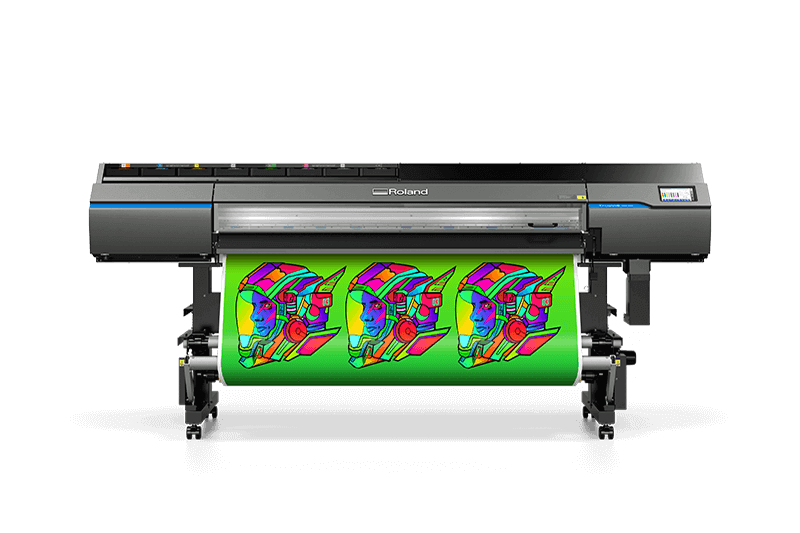
Las impresoras eco-solventes TrueVIS™ de la Serie VG3 de Roland DG ofrecen una gama cromática expandida.
TINTAS SOLVENTES Y ECO-SOLVENTES
Las tintas eco-solventes consisten en pigmentos suspendidos en una solución aceitosa. Las tintas solventes auténticas son de altas emisiones de VOC y a menudo dan como resultado impresiones con un olor bastante perceptible. Las tintas eco-solventes, por otro lado, usan extractos de aceite refinado que entregan varios beneficios; siendo degradables, de bajas emisiones de VOC, y adecuadas para una amplia variedad de aplicaciones.
TINTAS UV
Las tintas UV son aplicadas por un cabezal de impresión e inmediatamente curadas usando lámparas UV. Esto da como resultado un acabado altamente durable, y ya que no hay tiempo para que las tintas se dispersen o traspasen el sustrato, una calidad nítida es prácticamente garantizada al imprimirse sobre vinilo, plástico, madera, metal o casi cualquier otro material. Debido a esta versatilidad, es una opción popular tanto para la impresión directo-a-objeto (DTG) como para la impresión rollo-a-rollo de formato ancho.
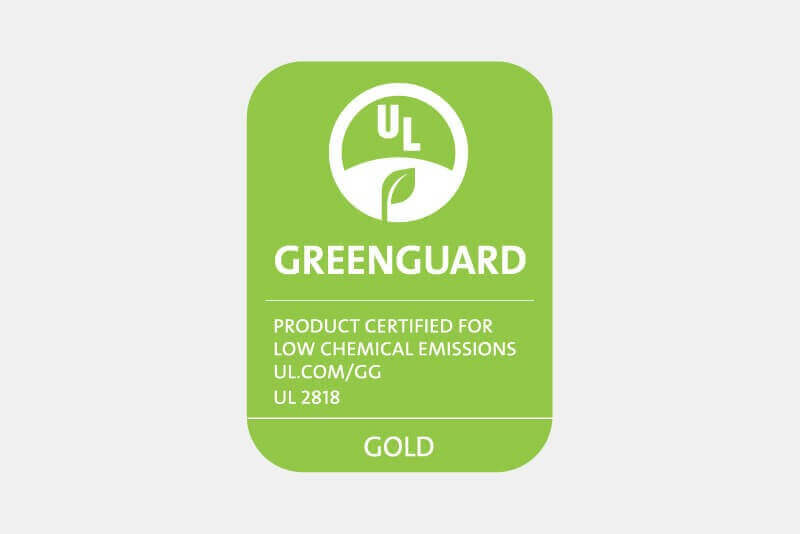
La certificación GREENGUARD garantiza que las tintas son seguras para su uso en entornos como escuelas y hospitales.
Certificación y Regulación de Tintas
La mayoría de tintas disponibles en el mercado están requeridas de cumplir estándares de seguridad química. Estas certificaciones son otorgadas por organismos oficiales e incluyen acreditaciones como OKEO-TEX Eco Passport y GREENGUARD. Aunque la mayoría de tintas serán adecuadas para aplicaciones de impresión típicas, algunos clientes como escuelas u hospitales están sujetos a reglas más estrictas. Si su objetivo son estos clientes, tiene que considerar usar tintas de impresión digital apropiadas para dichos entornos.
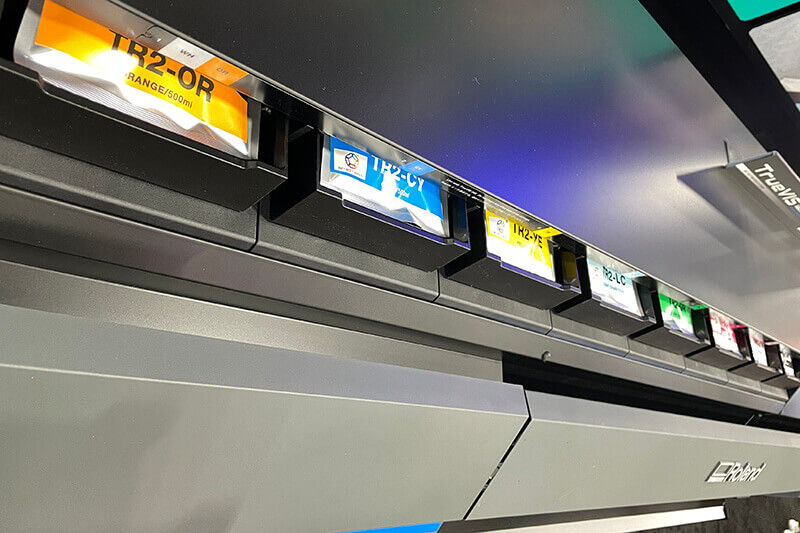
Usar las tintas recomendadas por el fabricante de su impresora le hace ahorrar tiempo y dinero a largo plazo.
Tintas de Fabricante de Equipo Original (OEM)
Muchos profesionales gráficos principiantes son tentados de reducir costos al comprar tintas hechas por fabricantes distintos a aquellos aprobados por la empresa que desarrolla el hardware. Aunque estas tintas pueden ser más baratas, son solo un ahorro a corto plazo. Ya que los dispositivos están diseñados a entregar una sola y determinada fórmula de tinta, las tintas de terceros pueden gradualmente dañar la impresora y dar como resultado tiempos de inactividad y gastos de reparación innecesarios. Además, la mayoría de garantías no cubrirán los daños causados por el uso de tintas no aprobadas. Por último, no hay garantía de que estas tintas de terceros hayan pasado los procesos de certificación mencionados anteriormente.
¿Necesita Ayuda para elegir la Tecnología Correcta de Tintas?
¿Tiene más preguntas? Comuníquese con uno de nuestros expertos que estará encantado de ayudarle. Comuníquese con nosotros hoy mismo.

